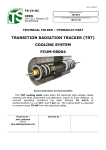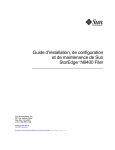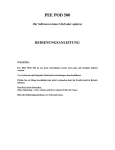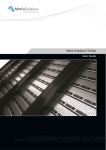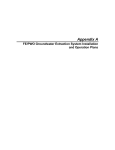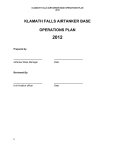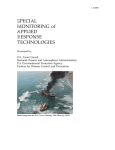Download RAM 2000 User`s guide
Transcript
United States Department of Agriculture Forest Service Technology & Development Program DataRAM 2000 Particulate Monitor Forest Service User’s Guide 2500 Watershed April 2002 0225-2803-MTDC Mary Ann Davies Project Leader USDA Forest Service Technology and Development Program Missoula, MT TE82F55—Watershed, Soil, and Air Technical Services April 2002 The Forest Service, United States Department of Agriculture (USDA), has developed this information for the guidance of its employees, its contractors, and its cooperating Federal and State agencies, and is not responsible for the interpretation or use of this information by anyone except its own employees. The use of trade, firm, or corporation names in this document is for the information and convenience of the reader, and does not constitute an endorsement by the Department of any product or service to the exclusion of others that may be suitable. The U.S. Department of Agriculture (USDA) prohibits discrimination in all its programs and activities on the basis of race, color, national origin, sex, religion, age, disability, political beliefs, sexual orientation, or marital or family status. (Not all prohibited bases apply to all programs.) Persons with disabilities who require alternative means for communication of program information (Braille, large print, audiotape, etc.) should contact USDA’s TARGET Center at (202) 720-2600 (voice and TDD). To file a complaint of discrimination, write USDA, Director, Office of Civil Rights, Room 326-W, Whitten Building, 1400 Independence Avenue, SW, Washington, D.C. 20250–9410, or call (202) 720-5964 (voice and TDD). USDA is an equal opportunity provider and employer. Contents Introduction _____________________________________ 1 The DataRAM 2000 _______________________________ 2 Items to Take to the Field __________________________ 3 Preparing the DataRAM for Field Operation ___________ 4 Charging the Battery ____________________________________ 4 Uncapping the Inlet _____________________________________ 4 Switching the Power Selector ______________________________ 4 Configuring the Instrument at Your Office ____________ 5 Setting the Date and Time ________________________________ Zeroing the DataRAM ____________________________________ Running the Span Check _________________________________ Setting Parameters ______________________________________ 5 5 5 6 Setting Up the Laptop at Your Office _________________ 7 Disabling the Infrared Port ________________________________ 7 Setting Up a Hyperterminal Connection ______________________ 7 Siting the DataRAM _______________________________ 8 Logging Data ____________________________________ 9 Terminating a Run _______________________________ 10 Transferring Data to the Laptop ____________________ 11 Deleting Data from the DataRAM ___________________ 12 Transferring Data Into Excel_______________________ 12 Remote Satellite Telemetry System for the DataRAM __ 13 Telemetry Equipment ____________________________ 13 Data Retrieval From the Internet ___________________ 14 DataRAM and Remote Telemetry Setup _____________ 15 DataRAM Configuration for the Telemetry Unit _______ 16 Sending Data to the Internet Site ___________________ 16 Laptop Setup for Telemetry Communications ________ 17 Appendix—Smoke From Forest Fires _______________ 18 ii Introduction This guide explains: • Where to site the DataRAM 2000 to collect local smoke data Omnidirectional sampling inlet model DR-OSI • How to assemble the instrument • How to start a run • How to stop a run • How to set up the laptop • How to download the data into the laptop Inline impactor head model DR-PM10/2.5 • How to transfer the data into an Excel spreadsheet. The guide will also help you set up the remote satellite telemetry system, assemble and configure the DataRAM for proper communication with the telemetry system, and verify that the system is sending data before you leave the site. Temperature conditioning heater model DR-TCH Inline heater power cable DataRAM 2000 particulate monitor The DataRAM 2000 instrument and accessories. 1 The DataRAM 2000 The DataRAM 2000 particulate monitor is a compact, self-contained instrument that internally estimates the mass concentration of particulate in the air from the measured scattering of light. The instrument can measure particulate concentrations from 0.1 to 400,000 micrograms per cubic meter of air. The instrument continuously displays the current and time-weighted average (TWA) mass concentration while logging up to 10,000 data points. Data can be transferred from the instrument to a laptop computer through the laptop’s RS-232 serial port. The DataRAM can be configured with either a PM2.5 or PM10 inlet head to prevent particles larger than 2.5 or 10 micrometers, respectively, from entering the optical chamber where particulate is measured. The DR-PM10/2.5 model of the DataRAM 2000 is shipped for PM10 operation. To convert the inlet to PM2.5 operation, a conversion nozzle is threaded onto the central flow tube. The PM2.5 micrometer inlet is recommended for monitoring smoke (figure 1). The impactor surface consists of a 25-millimeter-diameter glass fiber filter supported by one section of a standard plastic filter holder. Replace the glass filter when it has any brown or black soiled spots. Refer to the instruction note provided with the model DR-PM10/2.5 inline impactor head. A 37-millimeter filter located in the instrument’s base can collect particulates for custom calibrations, or for analyzing the chemical composition of particulates. An inline heater should be installed for conditions above 70 percent relative humidity. The inline heater requires 120-volt line power. Humidity of 70 percent and above may occur at any time in the early morning, even during low-humidity days. The tubular heater is designed to evaporate liquid water from airborne particles or to eliminate fog droplets. The DataRAM is powered by an internal rechargeable battery or by an external dc or ac power source. The Missoula Technology and Development Center (MTDC) recommends having 120-volt line power available for the DataRAM and inline heater. 2 Inline impactor head model DR-PM10/2.5 PM2.5 conversion nozzle 25-millimeter-diameter glass fiber filter holder Figure 1—Inline impactor head with the PM2.5 nozzle installed. The DataRAM is not approved by the U. S. Environmental Protection Agency (EPA) as a reference method sampler. The DataRAM instrument provides general trends of smoke particulate concentration. These data can enable the user to verify whether the impacts of smoke particulate are increasing or decreasing. A correction factor of 0.48 is applied to the DataRAM based on experimental data. In other words, if the DataRAM shows 100 micrograms of particulate per cubic meter of air, an EPA-approved reference method sampler would be expected to show about 48 micrograms of particulate per cubic meter of air. The center published Real-Time Smoke Particulate Sampling: Fire Storm 2000 (0125-2832-MTDC) which explains EPA airquality standards and how the DataRAM 2000 correction factor of 0.48 was determined. Items to Take to the Field These accessories are required for monitoring PM2.5: • DataRAM 2000 instrument Omnidirectional sampling inlet model DR-OSI • PM2.5 inlet head (optional accessory for the MIE model DR-PM10/2.5) • Temperature conditioning heater (optional accessory for the MIE model DR-TCH, figure 2) (120-volt line power) • Omnidirectional sampling inlet (optional accessory for the MIE model DR-OSI) Inline impactor head model DR-PM10/2.5 • Universal charger/power supply (120-volt line power) • Serial output cable (gray nine-pin communication cable for connecting to a laptop) Additional items needed: • Laptop computer Temperature conditioning heater model DR-TCH • Small table • Extension cord • Four-plug power strip DataRAM 2000 particulate monitor • Rain shelter cover (available from Mary Ann Davies at MTDC) • 120-volt line power for extended operation • Cable lock for security (wrap the cable around the DataRAM’s leg and another secure object) • Remote telemetry unit Figure 2—The DataRAM with all three ambient monitoring accessories. 3 Preparing the DataRAM for Field Operation Charging the Battery Uncapping the Inlet If the DataRAM has not been used for about 3 months, the battery will need to be fully recharged. Plug it into a 120-volt line for about 12 hours to restore it to full operating capacity. A new and fully charged battery can provide at least 20 hours of continuous operation at temperatures above 60 °F. The DataRAM can operate continuously using its universal charger/power supply—simply attach the universal charger/power supply to the DataRAM and plug it into a 120-volt power source. Never let the internal battery run completely down. If this happens, the unit may need to be sent to MIE for repair. Before operating the DataRAM, the protective Swagelok stem cap must be removed from the air inlet and stored on the gray pod on the back panel (figure 3). The DataRAM should never be operated with the stem cap covering the inlet. To determine the charge capacity of the battery, turn the DataRAM on. Inlet with protective Swagelok cap Universal charger/ power supply Span Check calibrator knob Power selector switch At ‘MAIN MENU 1’, press the button next to ‘System Diagnos’. 14:02:19 01 Oct MAIN MENU 1 RUN (zeroed?) System Diagnos Parameters Purge Zero Next Screen > > > > > > RS-232 cable to laptop Store Swagelok on this keeper RS-232 serial output cable (gray nine-pin communication cable) Figure 3—Back-panel view of the DataRAM. The system diagnostic screen will display. 14:02:19 01 Oct SYSTEM DIAGNOST Filter Normal Battery Normal Backgrnd Normal Flow Normal BatChrg 12345 Flowrate2.0 Lpm When the battery is fully charged, ‘BatChrg’ numbers ‘12345’ will display. 4 Switching the Power Selector The three-position, locking power-selector switch on the rear panel should be switched ‘OFF (0)’ (middle position) when the unit is stored or transported. To enable the DataRAM to operate with its internal battery or the charger, the power selector switch must be ‘ON (1)’ (up position). The ‘EXT (1)’ (down position) is used only when an external dc source (such as solar power or an external battery) is powering the unit. To change the locking position, pull the handle out while moving the power selector switch to the desired position. Configuring the Instrument at Your Office First, remove the Swagelok protective cap from the air inlet on the top of the DataRAM. The DataRAM 2000 internal pump turns on at powerup and continues to run during setup. The Swagelok cap should be stored on the keeper pod on the back of the unit. Select ‘Set Date, Time’ by pressing the button beside that selection. The first digit on the hour will flash. Use the ‘v’ or ‘^’ arrow buttons to change the numerals. Use the ‘>’ or ‘<’ arrow buttons to move across the date and time numerals. When the date and time are correct, press the ‘EXIT’ button to set them. Push the ‘ON’ button on the front panel to power up the DataRAM. Zeroing the DataRAM Setting the Date and Time The ‘MAIN MENU 1’ screen (figure 4) automatically displays at powerup. Press the ‘EXIT’ button once more or ‘Last Screen’ to return to ‘MAIN MENU 1’. 14:02:19 01 Oct MAIN MENU 1 RUN (zeroed?) System Diagnos Parameters Purge Zero Next Screen > > > > > > With ‘MAIN MENU 1’ displayed, press the button next to ‘Zero’. The DataRAM will perform a zero and span check to ensure that the optical device is clean. While the DataRAM is zeroing, the screen will flash ‘ZEROING’ and ‘WAIT’. 14:02:19 01 Oct ZEROING WAIT Figure 4—The DataRAM’s main menu screen. 14:01:19 01 Oct MAIN MENU 1 RUN (zeroed?) System Diagnos Parameters Purge Zero Next Screen > > > > > > After pressing ‘Next Screen’ on ‘MAIN MENU 1’, ‘MAIN MENU 2’ will display. 14:02:19 01 Oct MAIN MENU 2 DumpDataRS232 Set Date, Time ScrollDataLog Last Screen Running the Span Check After zeroing is complete, the DataRAM needs to perform a span check. 14:02:19 01 Oct ZERO COMPLETE Span Check > > > > > 5 Configuring the Instrument at Your Office Press the button next to ‘Span Check’. The following screen will display. If the CalFactor is not set to 48 percent, press the button next to ‘CalFactor’. Use ‘^’ or ‘v’ to increase or decrease the number and ‘<’ or ‘>’ to move across the number. 14:02:19 01 Oct • Set ‘CalFactor’ to 48 percent. • Set ‘Flowrate’ to 2.0 Lpm. • ‘Auto Zero’ and ‘Alarm’ can be set to ‘OFF’. insert calibrator At the back of the instrument is a black ‘Span Check’ knob with arrows showing how to rotate it ‘IN’ or ‘OUT’. While facing the screen, turn the ‘Span Check’ knob counterclockwise or ‘IN’ all the way until it stops. When the Span Check is complete, the screen will display ‘RETRACT CALIBRATOR’. On the bottom of the screen, the ‘Calibr Diff’ should range between plus or minus 10%. If the ‘Calibr Diff’ is more than ±10%, repeat the ‘Zero’ and ‘Span Check’ again. If the value is still outside the ±10% range, contact MIE, Inc. or MTDC. Turn the ‘Span Check’ knob clockwise when facing the screen or ‘OUT’ all the way until it stops. When the Span Check is complete, ‘MAIN MENU 1’ will display. 14:02:19 01 Oct PARAMETERS 2 Auto Zero: Alarm: CalFactor Flowrate If any parameters have been changed, press the ‘EXIT’ button to store the new settings. Press ‘EXIT’ one more time to go back to the ‘PARAMETERS 1’ screen. 14:02:19 01 Oct PARAMETERS 1 AvgTime: LogData: Setting Parameters ClearData: Tag#: Next Screen: Press the button beside ‘Parameters’. 14:02:19 01 Oct MAIN MENU 1 RUN (zeroed?) System Diagnos Parameters Purge Zero Next Screen > > > > > > Press the button beside ‘Next Screen’ to display ‘PARAMETERS 1’ menu. 14:02:19 01 Oct PARAMETERS 1 AvgTime: LogData: ClearData Tag# Next Screen 6 10sec> OFF> > > 1> > OFF> > OFF> > 048%> 2.0Lpm> 10sec> OFF> > > 1> > Setting Up the Laptop at Your Office Before transferring logged data to a laptop, you need to set up the laptop to receive the data. • Data bits > 8. • Parity > none. • Stop bits > 1. Disabling the Infrared Port • Flow control > Xon/Xoff. • Click ‘OK’. To disable the infrared (IR) port on a newer IBM ThinkPad: • Click on ‘Start’ (at the bottom left corner on the startup screen). • Double click on ‘Settings > Control Panel > Infrared’. • The ‘Infrared’ box is displayed. • Click on the page tab for ‘Options’. Uncheck the box ‘Enable infrared communication’. • The HyperTerminal window will open and show ‘Connected’ on the button at the bottom of the window. • Leaving the HyperTerminal window open, click on ‘File’ at the top of the window. Choose ‘Properties’. The ‘Name you gave to identify your HyperTerminal’ properties box will appear. • Click on the ‘Settings’ tab. • Check the ‘Terminal keys’ box. • The other two boxes on the ‘Preferences’ page can be left checked. Click ‘OK’. • Close the control panel by clicking on the ‘X’ at the upper right corner of the window. • Click on the arrow next to ‘Emulation’ and choose ‘TTY’. • The ‘Backscroll buffer lines’ box needs to be set to 500. Type ‘500’ or use the increase/decrease arrows to get to 500. • Click on the page tab for ‘Preferences’. Check the box ‘Display infrared icon on task bar’. This places an infrared icon with a slash across it at the bottom right of the startup screen to verify that the infrared port is disabled. • Click on the ‘ASCII Setup’ box. • Check ‘Send line ends with line feed’. • Check ‘Echo typed characters locally’. • Check ‘Append line feeds to incoming line ends’. Setting Up a Hyperterminal Connection • Check ‘Wrap lines that exceed terminal width’. • Click ‘OK’. • Click on ‘Start’ (at the bottom left corner on the startup screen). • Click ‘OK’ on the ‘Properties’ page. • The ‘HyperTerminal’ screen will display. • On the button bar at the top of the HyperTerminal window, click on the phone that has the receiver off. This will disconnect communications for now. The bottom bar in the HyperTerminal will display ‘Disconnected’. • The ‘Connection Description’ box will appear. Type in a name and pick an icon to identify your HyperTerminal. • On the menu bar at the top of the HyperTerminal window, click ‘File > Save As’. • Click ‘OK’. • Click on the down arrow on the right side of the ‘Save In:’ dialog box and choose ‘Desktop’. • Click on ‘Programs > Accessories > HyperTerminal (single click) > Hypertm.exe’ (double click). • The ‘Phone number’ box will appear. At the bottom of this box, click on the arrow beside ‘Connect Using’ and choose ‘Direct to Com 1’. Click ‘OK’. • The ‘Com 1 Properties with Port Settings’ box will appear. Click on the arrow next to ‘Bits per second’ and choose ‘9600’. • The name you chose for your HyperTerminal will appear in the ‘File name:’ dialog box. • Click ‘Save’. • Close the HyperTerminal window by clicking ‘File > Close’ on the menu bar at the top. 7 Siting the DataRAM The DataRAM should be placed at least 3 feet off the ground and away from obstructions (such as trees or buildings) that may influence airflow. It should be in an area where it will not be influenced by road dust, industrial pollutants, or other sources of particulate that could increase its readings. The DataRAM should usually be sited several miles downwind of the burn in areas of greatest interest, such as communities or protected areas. The best use for the DataRAM is to determine whether the local particulate concentration is relatively high or low, and whether concentrations are going up or down. Acquire ambient background particulate concentrations before the burn to determine clean background conditions. If the instrument is to be left unattended, place it in the weather-resistant shelter. Be careful to insert the uncapped inlet port through the hole in the shelter. Once the DataRAM is in the shelter, place the heater, 2.5-micrometer cut-point device, and omnidirectional inlet on the DataRAM inlet port. The DataRAM power charger and power strip can fit inside the cover behind the instrument. The DataRAM is sited in an open field for collecting smoke data. 8 Logging Data • At the ‘MAIN MENU 1’ screen, press the button next to ‘Parameters’. At the ‘PARAMETERS 1’ screen, press the button next to ‘LogData’. When LogData switches from ‘OFF’ to ‘ON’, a line appears below LogData requesting an update time for an average of points. • Press the button next to ‘Every: 00:00:10’ line. The first zero on the hour digits will flash. • Use ‘^’ or ‘v’ to increase or decrease the number value and ‘<’ or ‘>’ to move across the number. • Set ‘Every’ to 5 minutes (00:05:00). This time will need to be entered every time the instrument is reset to LogData. ➥ 14:02:19 01 Oct PARAMETERS 1 AvgTime: LogData: Every: 00:05:00 ClearData Tag# Next Screen • Press ‘EXIT’ once more to return to ‘MAIN MENU 1’. 14:02:19 01 Oct MAIN MENU 1 RUN (zeroed?) System Diagnos Parameters Purge Zero Next Screen > > > > > > • Press ‘RUN (zeroed?)’ to begin logging data.The (zeroed?) is a reminder that the instrument needs to be zeroed before every run. The following screen displays. 10sec> ON> > > 1> > • Press ‘EXIT’ to set ‘Every: 00:05:00’. 14:02:19 01 Oct u RUN DATA Conc 002.1 µg/m3 TWA 001.0 µg/m3 ET 00:00:03:43 MemoryFree L 100% CalFactor: 048% System Diagnos > • Set ‘AvgTime’ to 10 seconds. • Set ‘Tag#’ to 1. Note the flashing ‘L’ next to ‘Memory Free’. The L verifies that data is being logged. The ‘Conc’ and ‘TWA’ values should be updating every 10 seconds. • If the values for ‘AvgTime’ or ‘Tag#’ need to be changed, press ‘EXIT’ to set the values. 9 Terminating a Run • At the ‘RUN DATA’ screen, press ‘EXIT’. The following screen will appear. 14:02:19 01 Oct Terminate Run To continue RUN Key ‘EXIT’ 10 > • Press the button beside ‘Terminate RUN’. The ‘MAIN MENU 1’ screen displays. 14:02:19 01 Oct MAIN MENU 1 RUN (zeroed?) System Diagnos Parameters Purge Zero Next Screen > > > > > > Transferring Data to the Laptop • Attach the RS-232 cable (gray nine-pin cable) from the DataRAM to the laptop. • On the laptop, open the ‘HyperTerminal’ icon created in the ‘Laptop Setup’ section. • ‘Connected’ should display at the left side of the bottom bar of the HyperTerminal window. • If not, connect by clicking on the phone button on the button bar at the top of the HyperTerminal window—or by clicking on ‘Call > Connect’ in the menu bar above the button bar. • On the menu bar, click on ‘Transfer > Capture Text’. • The ‘File’ window should read: Capture Text Folder: C:\windows\desktop\ File: \windows\desktop\Capture.TXT • Select the key beside ‘DumpDataRS232’. 14:02:19 01 Oct MAIN MENU 2 DumpDataRS232 Set Date, Time ScrollDataLog > > > • The screen will display the following. DUMP DATA LOG MermoryFree 100% TagsUsed? > Select Tag# 1> DumpTagSummary > DumpTagData > DumpAllData > ClearData > • Select the key beside ‘DumpAllData’. DumpAllData will flash as it sends data to the laptop. Next to ‘DumpAllData’, a number will appear indicating the Tag# that is being downloaded to the laptop. Start • If the ‘File’ window doesn’t read as shown above, type the information into the box. • At the laptop, the data being transferred will scroll down the screen. • Click the ‘Start’ button in the ‘Capture Text’ window. • [Capture].TXT is the default filename given to the data being downloaded. You can type in a different name if you wish. End the filename with the ‘.TXT’ extension. • Click on the ‘Start’ button on the laptop. • The DataRAM screen should be at ‘MAIN MENU 1’. Press the key beside ‘Next Screen’. 14:02:19 01 Oct MAIN MENU 1 RUN (zeroed?) System Diagnos Parameters Purge Zero Next Screen • Stop the ‘Capture’ by clicking on ‘Transfer > Capture Text > Stop’ on the menu bar at the top of the HyperTerminal window. • Disconnect the connection by clicking on the disconnected phone button on the button bar at the top of the HyperTerminal window. • Close or minimize the ‘HyperTerminal’ window. • Double click to open the ‘[your filename].TXT’ file to verify that the data were transferred to the laptop. > > > > > > 11 Deleting Data From the DataRAM Transferring Data Into Excel • From ‘MAIN MENU 1’, select ‘Parameters’. • Click on the ‘Start’ button on the bottom left of the screen. Select ‘Programs > Excel’. 14:02:19 01 Oct PARAMETERS 1 AvgTime: LogData: ClearData Tag# Next Screen • On the Excel menu bar, click ‘File > Open’. 10sec> OFF> > 1> > • If you placed the ‘[your filename].TXT’ file on the desktop, the ‘Open’ window will have the ‘Desktop’ icon on the left side of the open window. Click on ‘Desktop’. • Click on the triangle beside the ‘Files of type’ dialog box. Select: ‘All Files (*.*)’. • ‘Clear’ will be flashing on the ‘ClearData’ line. • Double click on the ‘[your filename].TXT’ file. • Select the key beside the ‘ClearData’ line. • The ‘Text Import Wizard’ box will appear. Check ‘Delimited’. 14:02:19 01 Oct PARAMETERS 1 AvgTime: LogData: 10sec> OFF> No : Exit Tag# Next Screen Clear: > 1> > • Click ‘Next’. • Select the key next to ‘Clear’. The screen will return with ‘ClearData’ on that line. The data has been deleted. • Check the ‘Comma’ box. The ‘Tab’ box can stay checked. • Scroll down past the header information to view the data being imported. • Click ‘Finish’. • The ‘[your filename].TXT’ file should come into the Excel program with the data in separate columns • Click ‘File > Save As’ on the menu bar. • Turning the DataRAM off—The ‘OFF’ button turns the instrument off. The DataRAM will purge clean air for a few seconds, then turn itself off. Place the protective Swagelok stem cap back on the air inlet before storing the DataRAM. • Give the file a useful name (date, fire, and so on) with an ‘.XLS’ extension. • When the data has been saved in Excel, the ‘[your filename].TXT’ file should be saved as the orginal data. 12 Remote Satellite Telemetry System for the DataRAM The remote satellite telemetry system uses a low-orbit satellite system to send data from the DataRAM to a base station where the information can be viewed and retrieved on the Internet. The system sends 5-minute average mass concentrations hourly by satellite to the Web site where the data will be posted for up-to-date, easy access. The data can be copied from the Internet site into a database or spreadsheet application for analysis. Telemetry Equipment All the equipment needed for the remote telemetry unit (figure 5) is in a rugged black Pelican briefcase. The system consists of a satellite modem, two batteries and a charger for backup power, a satellite antenna, power cable, and a serial cable for communications between the satellite modem and the DataRAM. Satellite an tenna Serial cable to DataRAM Power cord Serial cable to laptop ‘ON’ button Figure 5—Remote telemetry unit used with the DataRAM. 13 Data Retrieval from the Internet The remote satellite telemetry system sends the data from the DataRAM by satellite to a base station where the data can be retrieved by the Internet. The Internet site address is http:// www.satguard.com/usdafs. The site requires a username and password. Telephone Andy Trent (MTDC), 406–329–3912; Jim Drewett (ADSI, Inc.), 619–585–0435; or Jeff Ogburn (Air Resource Specialists), 970–484–7941, for this information. The Web site will also require you to have the unit number of the satellite system. The designated unit number for the satellite system is inside the briefcase (for example, unit USFS 35). The Web site will show the current ambient particulate concentrations for your unit. Data from previous days may be viewed by changing the date. Times are in Greenwich Mean Time (table 1) and must be converted to your location. You can use this chart or use the conversion chart at the Internet site to convert Greenwich Mean Time to your time zone. A separate Web page shows data in a tabular form. These data may be copied into a spreadsheet application like Microsoft Excel. 14 Table 1—Conversion from Greenwich Mean Time to time in United Sates time zones. Time Zone Subtract Eastern Standard Time 5 hours Eastern Daylight Time 4 hours Central Standard Time 6 hours Central Daylight Time 5 hours Mountain Standard Time 7 hours Mountain Daylight Time 6 hours Pacific Standard Time 8 hours Pacific Daylight Time 7 hours DataRAM and Remote Telemetry Setup • Open the remote satellite telemetry briefcase (figure 6) and remove the pouch containing the required cables. • Remove the satellite antenna in the top of the briefcase by slowly threading it through the retaining clips. • Screw the antenna into its magnetic base and attach the base’s cable to the briefcase. The base of the antenna should be at least 3 feet off the ground for best results. • Attach the serial cable to the RS-232 port on the back of the DataRAM and to the serial connection on the briefcase. • Attach the power cord to the three-prong connector on the side of the briefcase and plug the cord into a 110-volt power outlet. • Ensure that all battery connections are snugly attached to the battery terminals. • Turn on the power switch inside the briefcase. The red light should illuminate. Figure 6—DataRAM connected to the telemetry unit. 15 DataRAM Configuration for the Telemetry Unit Sending Data to the Internet Site Because the data will be available over the Internet and are stored indefinitely, it is not necessary to log the data. However, you may still want to log the data for backup or in case the satellite system has technical problems. If so, refer to the Logging Data section for instructions. To begin sending data to start a run, press the key next to ‘Run (zeroed?)’. To ensure proper functioning of the remote satellite telemetry system, the DataRAM must be set to average data every 10 seconds. To do this from the ‘MAIN MENU 1’ screen, press the button beside ‘Parameters’. Set ‘AvgTime’ to 10 seconds. 14:02:19 01 Oct PARAMETERS 1 AvgTime: 10sec> LogData: ON> Every : 00:05:00> ClearData > Tag# 1> Next Screen > Press ‘EXIT’ to go back to ‘MAIN MENU 1’. Note: Logging data without the telemetry unit requires ‘Every’ to be set at ‘00:05:00’. Refer to the Logging Data section. 16 14:02:19 01 Oct MAIN MENU 1 RUN (zeroed?) System Diagnos Parameters Purge Zero Next Screen > > > > > > The ‘(zeroed?)’ is to remind you that the instrument needs to be zeroed before every run. The system will begin sending data after about 1 hour. Within 2 hours, the data will be posted on the Internet site. The data will be updated hourly. Laptop Setup for Telemetry Communications To verify that the satellite is sending data to the Internet site, the HyperTerminal communications will need to be set up differently than when it is used for DataRAM communications. Refer to the Setting Up a HyperTerminal section for the basics. • At the ‘Port Settings’ box, click on the arrow beside ‘Bits per second’. Choose ‘19200’. • Look for the ‘Last value’ number displayed in the scrolling data. It should match the displayed concentration value on the DataRAM. value 58.9; Rx[12Oct01 ➥Last 16:23:22|269.00]Sync(20* 90 02): Dplr -2800 Pwr -10 • Data Bits > 8. 0 Ebno 18.6 0/50 • Parity > none. Rx[12Oct01 16:23:23|270.00]Sync(20* 90 03): Dplr -2800 Pwr -100 Ebno 18.0 0/ 50 • Stop Bits > 1. • Flow Control > none. Rx[12Oct01 16:23:24|270.08]Ephem: Sat 20 Week 1135 Time 491003 Delta-1 • Click ‘OK’. • Attach the RS-232 cable (gray nine-pin cable stored inside the Pelican case) from the modem to the laptop. The HyperTerminal window should show ‘Connected’ at the bottom of the laptop screen. The data displayed on the screen will show: • Disconnect the RS-232 cable and place it back in the case. If you do not obtain the data, contact MTDC for help. Rx[12Oct01 16:23:21|268.00]Sync(20* 90 01): Dplr -2800 Pwr -100 Ebno 18.5 0/ 50 Rx[12Oct01 16:23:22|268.38]UL Chan Info(1/1): ACsz 4 ACrtry 5 375,275,0,0 Update ser stats Received f_val = 58.900002 17 Appendix—Smoke From Forest Fires Particulate matter (PM) from burning biomass is comprised largely of elemental and organic carbon, as well as polycyclic aromatic hydrocarbons and trace minerals. Particulate matter is the major pollutant from wildland fire smoke. Smoke particles tend to be very small—less than 1 micron in diameter. Particulate matter from wood smoke has a size range near the wavelength of visible light (0.4 to 0.7 micrometers). These particles are the right size to scatter light and reduce visibility. Respiratory-related health effects have been associated with biomass burning, particularly for sensitive groups (persons with respiratory or cardiovascular diseases, the elderly, and children). Airborne concentrations of particulate, especially particulate smaller than 2.5 micrometers in diameter (PM2.5), pose health, visibility, safety, and nuisance problems. The proposed U.S. Environmental Protection Agency standard for PM2.5 is 65 micrograms per cubic meter for a 24-hour average. At PM2.5 levels higher than 65 micrograms per cubic meter, visibility is reduced to 2.5 to 3 miles and air quality may be considered unhealthy. For help answering smoke-related questions, see Wildfire Smoke: A Guide for Public Health Officials: http://www.deq.state. mt.us/FireUpdates/Guide_for_Public_Health_Officials.doc Smoke Management Plans—A comprehensive smoke management plan is essential for the successful use of fire as a wildland management tool. Monitoring ambient air to ensure that smoke does not threaten people or protected areas is an essential element of each prescribed burn plan. The proper use of ambient air monitoring can help ensure that wildland burning complies with State and Federal air-quality laws and regulations while satisfying land management objectives. The real-time estimated mass concentrations of particulate from smoke can be used by the Forest Service to help manage a burn and its production of smoke. If concentration levels show rising trends that may affect a local community, fire managers may alter the lighting technique to produce better smoke dispersion or they may decide to extinguish the fire. During wildland fires, the DataRAM can be sited near population centers or rural communities to provide PM2.5 concentration estimates for land managers and public health officials. Such data can be used to determine the need for health advisories for the general public. Health Advisory Categories for Montana With Corresponding Air-Quality Index (AQI) and Visibility Values (Check the values for your state; they may be different.) Visibility (miles) Categories Good Particulate levels PM2.5 (averaged 1 hour, micrograms per cubic meter) Particulate levels PM2.5 (averaged 24 hours, micrograms per cubic meter) 10 or more 0 to 40 0 to 15.4 Moderate 6 to 9 41 to 80 15.5 to 40.4 Unhealthy for sensitive groups 3 to 5 81 to 175 40.5 to 65.4 Unhealthy 1.5 to 2.5 176 to 300 65.5 to 150.4 Very unhealthy 0.9 to 1.4 301 to 500 150.5 to 250.4 0.8 or less Over 500 Over 250.5 Hazardous (Based on Helena, MT, empirical study (July 2000 Montana Department of Environmental Quality) 18 About the Author Mary Ann Davies received a bachelor’s degree in mechanical engineering with a minor in industrial and management engineering from Montana State University in 1988. She worked in the Pacific Northwest Region as a facility engineer and as a tramway engineer. She also developed mountain bike routes using a rating system she designed. Mary Ann has worked in fire management as a crewmember and as a crewboss. She worked for 5 years with the Rocky Mountain Research Station in the fire chemistry and fire behavior groups before coming to MTDC in 1999. Library Card Davies, Mary Ann. 2002. User’s guide for the DataRAM 2000 particulate monitor. Tech. Rep. 0225-2803-MTDC. Missoula, MT: U.S. Department of Agriculture, Forest Service, Missoula Technology and Development Center. 18 p. and how to transfer the data into an Excel spreadsheet. The guide also explains how to set up the remote satellite telemetry system, assemble and configure the DataRAM for proper communication with the telemetry system, and verify that the system is sending data. Describes how to set up the DataRAM 2000 particulate monitor to collect smoke data. The guide explains where to site the instrument, how to start a run, how to stop a run, how to set up a laptop computer, how to download the data into the laptop, Keywords: air pollution, air quality, configuration, data collection, data communication, instruments, nephelometers, particulate, telemetry, wood smoke Additional single copies of this document may be ordered from: For additional technical information, contact Mary Ann Davies at MTDC. USDA Forest Service, MTDC 5785 West Broadway Missoula, MT 59808-9361 Phone: 406–329–3978 Fax: 406–329–3719 E-mail: [email protected] Phone: 406–329–3981 Fax: 406–329–3719 E-mail: [email protected] Electronic copies of MTDC’s documents are available on the Forest Service’s FSWeb Intranet at: http://fsweb.mtdc.wo.fs.fed.us






















